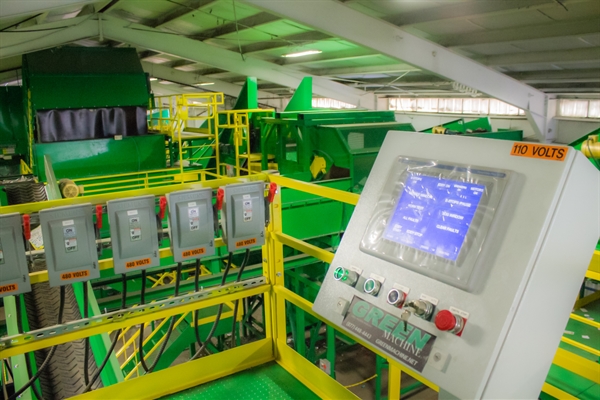 In July 2017, TC Recycling debuted our new state-of-the-art recycling machinery. This new equipment is able to process 600 tons of recyclable materials per week, greatly increasing our efficiency and decreasing the amount of material sent to the landfill.
In July 2017, TC Recycling debuted our new state-of-the-art recycling machinery. This new equipment is able to process 600 tons of recyclable materials per week, greatly increasing our efficiency and decreasing the amount of material sent to the landfill.
Our investment in this new sorting line has benefits at every point in the recycling process:
You, Our Customers:
By increasing our efficiency, we are able to process more materials. That means the Vogel Holding, Inc. family of businesses have the ability to offer single-stream recycling to more of our clients.
Single-stream recycling is the easiest way for you to get rid of your recyclable materials. All of your recyclables can go into one can instead of being separated by type. You don't even need to put your recyclables into bags - in fact, we would prefer that you don't use bags for recyclables. Bags, even the blue ones, have to be cut open and can jam up our machines.
If you do not yet have single-stream (no-sort) recycling, please contact your hauling company to see if it is available in your area.
Our Employees:
Our new machinery eliminates much of the manual labor of sorting recyclable materials, making the job safer for our line members. As materials go down the line, our Green Machine equipment sorts material types automatically using magnets, optical sorters, glass crushers, shakers, blowers and other methods. Our pickers will have less need to handle materials on the belt, which can sometimes be sharp or contaminated.
The Green Machine is equipped with safety features such as emergency stops to keep our employees safe.
Our Landfill:
Our new equipment can process 600 tons of recyclable materials per week. Those materials might otherwise have ended up in Seneca Landfill. While landfills are necessary and have many benefits, their space is limited and certain materials do not break down quickly. Recyclable materials linger in landfills, taking up valuable space, for years or longer.
By processing more materials with greater accuracy, we help ensure that plastics, metals, paper and other recyclable materials are able to be reused instead of wasted. This saves space in the landfill as well as conserving natural resources used to make consumer goods.
How Does It All Work?
Loading Recyclables into the Green Machine
TC Recycling recently installed a Green Machine single stream recycling system. Here, a front-end loader deposits mixed recyclable materials from both residential and commercial sources into a dual-side feed metering bin system.
Elevating and Pre-Sorting
The material is then deposited upon an in-feed system which elevates the materials up to a pre-sort mezzanine area. Sorters manually remove heavy metals, plastic bags and rigid plastics from the stream.
Cardboard Removal
The Green Machine OCC Separator system is designed to remove large bulky cardboard from smaller mixed containers and small fibers. The bulky cardboard is then deposited upon a post-sort conveyor where sorters perform a manual post-sort, removing any non-brown, non-cardboard materials. Cardboard is later baled and shipped for processing.
Paper and Fiber Removal
The material which passes through the OCC stream is deposited upon a Green Machine polishing system, which separates fibers (such as paper) from containers. The fibers rise to the top of the stream and are deposited upon a post-sort conveyor, where inspection sorters remove any non-fiber material. Clean paper and fiber materials are later baled and shipped for processing.
Mini Polisher and Glass Breaker
The mini polisher system takes the material which falls off the major polisher for a secondary cleanup, helping to remove the balance of the fibers from the containers. The containers fall off the bottom of the stream, and then travel across a glass-breaker system, where glass is removed and fiber is then also removed from the glass product. Clean glass is deposited outside in a bunker for daily landfill cover or glass recycling.
Ballistic Bounce Separator
Again, containers removed from the bottom of the mini polisher stream are deposited upon a glass breaker, where fines are removed. Those containers are then transported to a Green Machine ballistic bounce belt separator, where fibers and 2-D materials rise to the top of the separator and containers fall off the bottom. Containers and non-conforming fibers are manually removed from the stream.
PET and HDPE Removal
Then, HDPE sort system removes all of the high-density polyethylene plastic bottles, such as laundry detergent and milk jugs, for post-sort.
Aluminum Removal
The eddy-current separator removes all aluminum UBCs (used beverage cans) from the waste stream.
Material Separation and Storage
Bunkers holding sorted, clean materials are automatically discharged, flow to a baler feed conveyor which then flows to a final processing/baling system.
Baling Materials
The baler makes highly densified bales of product, tying them with wire for transportation via truck. Although this is the last stage in the process at the TC Recycling facility, the materials we process go on to be used by our customers to create new products.